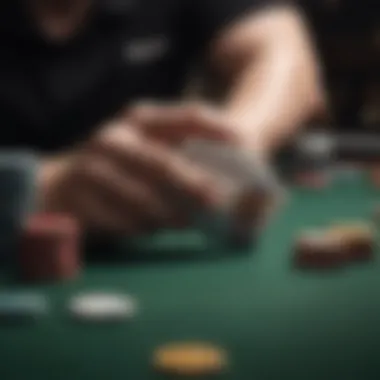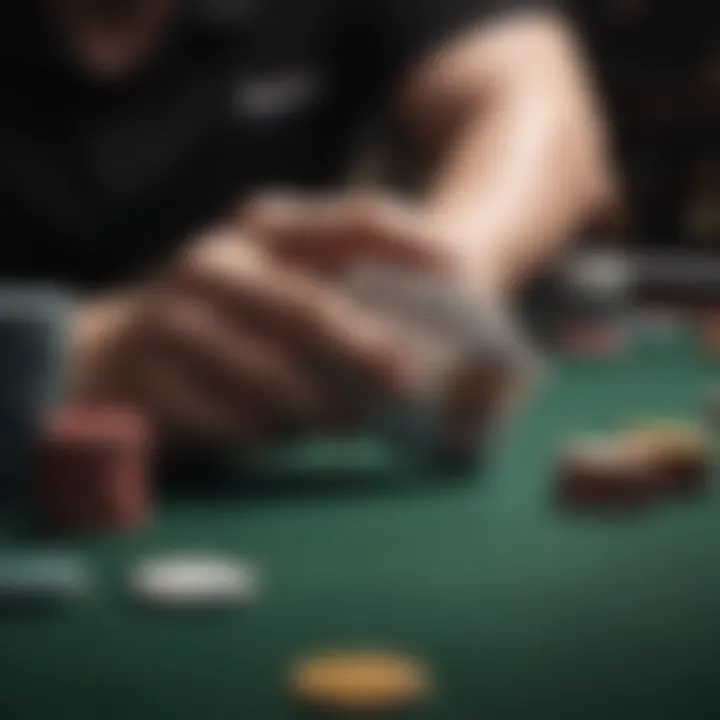Mastering 2-Handed Poker: Strategies for Success


Intro
2-handed poker, often viewed as the ultimate test of a player's skill, sharpens the focus to a fine point. It's not just about the cards you hold; it's about your ability to adapt strategies and read your opponent’s moves. In the battle of wits, understanding the nuances can be the difference between success and failure. Players must engage with every hand in a manner that's both strategic and intuitive. Hence, this deep dive into poker tactics is essential for anyone looking to improve their game.
While many resources discuss 6-handed or 9-handed formats, the dynamics found in 2-handed poker forge a unique ecosystem wherein aggression, patience, and psychological strength reign supreme. Throughout this guide, we will explore intricate strategies—offer insights tailored for both newcomers and battle-hardened players. Our focus will revolve around techniques that don't just see you through matches, but set you apart in a sea of competitors.
It’s time to roll up your sleeves and discover what it takes to not just play but master the art of 2-handed poker.
Understanding 2-Handed Poker
In the realm of poker, mastering the nuances of 2-handed play is not just a trivial pursuit; it represents a fundamental shift in strategy and thinking. Unlike games involving more players, where the dynamics can become chaotic, 2-handed poker offers a unique landscape that demands a distinct approach. Diving into this topic is crucial for any serious player as it shapes your understanding of both the game and your opponent.
The essence of 2-handed poker lies in how the dynamics can shift with just one opponent. It’s a dance between two players, each vying for control of the pot. Because there’s less competition at the table, individual player actions become even more impactful. Adjusting to an opponent's style and being aware of your betting patterns is not simply beneficial but essential.
Furthermore, grasping 2-handed dynamics can sharpen your overall poker skills. You develop a stronger sense of hand strength, positional value, and strategic depth. While multiplayer games require you to read several players at once, in 2-handed poker, you turn your focus toward recognizing the shifts in just one opponent's behavior, effectively enhancing your analytical abilities.
Overview of Game Dynamics
In 2-handed poker, each hand plays out like a mini battle. The stakes are high, and the interplay of aggression and caution becomes vital to your success. Key factors such as starting stacks, the effective stack size, and blind levels closely influence the dynamics of play. Here are important dynamics to consider:
- Chip Stack Management: With only two players, short stacks change the dynamics significantly. Players often feel the pressure to play differently as they aim to either preserve or accumulate chips.
- Aggression: Unlike in a multiplayer setting, where players might wait for premium hands, 2-handed poker rewards aggressive play. Being the one to set the tone of the betting is often a path to success.
- Position: In 2-handed games, position loses some of its nuanced importance but is still significant. The player who acts last has more information about the opponent's actions, shaping betting decisions.
Understanding these dynamics equips you with the necessary tools to engage effectively, making every play intentional.
Differences Between 2-Handed and Multiplayer Games
The game of 2-handed poker starkly contrasts with its multiplayer counterpart, presenting unique challenges and opportunities. One notable difference is that in 2-handed games, each hand tends to stay more straightforward due to the limited number of players. In contrast, multiplayer games can involve complex strategies as the actions of many players come into play.
- Hand Ranges: In a multiplayer setting, players may tighten their hand ranges due to the number of opponents, whereas in 2-handed play, players often widen their ranges. This necessity arises because the chances of facing stronger hands diminishes with fewer players.
- Emotional Factors: With just two players, the psychological aspects of the game—like intimidation or confidence—become magnified. Reading your opponent’s facial expressions and body language becomes more direct and accessible.
- Adaptability: In multiplayer games, it's common to see players stick to established strategies that account for various opponents. However, in 2-handed play, the ability to adjust strategies based on your opponent's tendencies is much more pronounced and vital.
Core Strategies for Success
In the realm of 2-handed poker, grasping the core strategies can set a player apart from the rest of the pack. Unlike large table formats, the dynamics shift dramatically in a two-player showdown. The ability to adapt and refine one's game plan is crucial. This section examines the key elements that can lead to success, providing oil to the gears of smart gameplay and tactical supremacy.
Hand Selection and Range Construction
Selecting the right hands to play is the foundation of a robust 2-handed poker strategy. In this format, everything is heightened—each hand matters significantly more. Unlike multiplayer tables where you might be content to play a wider range and hope for good luck, in a heads-up match, you need to be strategic about your selections.
When considering hand ranges, take note of the following:
- Premium hands should always be included in your starting lineup. Hands like Ace-King or pocket pairs are not just strong; they can dominate your opponent.
- Suited connectors add a dimension of adaptability, allowing you to chase straights and flushes, increasing your chances of hitting a strong hand on the flop.
It's essential to balance your range. Playing too tightly can make you predictable, while a loose approach may lead to overcommitment on weak hands. Fine-tuning your decisions based on your opponent’s tendencies can yield better results.
"In poker, as in life, adaptability is key. Play smarter; don’t just play harder."
Positional Awareness in 2-Handed Play
In 2-handed poker, positional awareness becomes a critical determinant of a player’s success. Unlike in standard multiplayer scenarios, both positions (the button and the big blind) turn over quickly, fostering frequent strategic opportunities. This constant change urges a player to pivot their strategy based on their standing in each hand.
- Button Advantage: If you are in the “button” position, you have the luxury of acting last in every round of betting. This is prime real estate in poker. Use it to your advantage by putting pressure on your opponent. In many situations, this means betting aggressively to keep them off balance.
- Adjusting from the Big Blind: When you find yourself in the big blind, your strategy should revolve around defense. It’s often advisable to defend your blind carefully and try to force mistakes from your opponent. Look for moments to trap or leverage their aggressive plays against them.
Being keenly aware of how your position shifts can lead to well-timed bluffs and strategic value bets, ensuring that you stay unpredictable.
Aggression and Betting Patterns
Aggression is a double-edged sword in poker. In 2-handed games, you need to wield it thoughtfully. Here’s how:
- Balance Aggression: Employ a mixture of value betting and bluffs. Not everything you bet needs to be a monster hand; including bluffs in your range keeps your opponent guessing.
- Reading Patterns: Pay close attention to how your opponent reacts to your bets. If they fold often to aggressive plays, amplify your bluffs. Conversely, if they seem to enjoy playing back at you, consider tightening up and only betting strong hands.
Additionally, be sure to vary your bet sizing. Different amounts can elicit different reactions. Shorter bets might induce calls from weaker hands while larger bets can often scare off uncertain hands.


Each round presents a new opportunity to exploit betting patterns and build a narrative—a story that leaves your opponent scratching their head.
Psychological Tactics
In the competitive realm of 2-handed poker, mastering psychological tactics is akin to wielding a secret weapon. Unlike larger multiplayer games, where strategies often revolve around basic hand strength and betting behaviors, 2-handed poker demands a deeper dive into the human psyche. The singular interplay between two players allows for a close examination of behavioral cues, which can provide a distinctive edge. Knowing how to read your opponent while also managing your own demeanor shapes the outcome significantly.
Reading Your Opponent
Understanding your opponent's style and habits is crucial in 2-handed poker. Every player has their own distinctive patterns, even if they don't realize it.
- Recognizing Bet Patterns: Pay attention to how your opponent bets. Do they tend to go all in when they’re strong? Are they more timid with weaker hands? These habits can inform your decisions on whether to fold or push forward.
- Facial Expressions and Body Language: Often, players reveal more than they intend through subtle cues. A slight twitch or a moment of hesitation can indicate uncertainty or confidence. Developing a sensitivity to these nuances can be beneficial.
- Timing and Rhythm: Observe not just what is played but also how. A player who consistently takes a long time to make a decision could be indicating they're unsure of their hand strength. Alternatively, quick bets might signal confidence—or bluffing.
Ultimately, being able to detect slight shifts in your opponent’s behavior can offer invaluable insights, helping you adjust your strategy on the fly.
Maintaining Composure at the Table
Staying cool under pressure is an art form in 2-handed poker. The stakes can feel higher when there’s only one other player in the ring, and maintaining your composure can make a world of difference in your game. Here are some aspects to consider:
- Emotional Awareness: Recognize your feelings during the game. If you sense frustration or excitement, take a moment to regain your focus. A calm mind tends to make better decisions than a reactive one.
- Breathing Techniques: It might sound simple, but controlled breathing can help keep your nerves in check. When the pressure is on, taking a deep breath before making a decision can provide the clarity you need to make informed choices.
- Rituals and Routine: Establish a personal routine for yourself when you sit down to play. This familiar structure can help ease any anxiety and ground you, allowing for smoother gameplay.
"In 2-handed poker, it's not just about the cards you hold, but the mental game you play with your opponent."
Recognizing the psychological aspect is vital. It is what separates the amateurs from seasoned pros. A high-IQ audience will appreciate the complexity and subtleties involved, knowing all too well that poker isn’t merely a game of chance; it's a dance of minds in a strategically charged atmosphere.
Adjusting Strategies Based on Opponent Style
Understanding how to adjust your strategies based on your opponent’s style can significantly impact your success in 2-handed poker. Each player has a unique approach to the game, influenced by factors such as their personality, level of experience, and understanding of poker fundamentals. Recognizing these styles can help you tailor your play to exploit weaknesses and minimize risks.
When you've identified how an opponent typically plays, you position yourself to make strategic decisions that align with the overall dynamics of the table. It’s crucial to be flexible and capable of adapting your approach—doing so can often be the difference between winning or losing in intense play.
Identifying Loose vs. Tight Players
One fundamental aspect to consider is whether a player is loose or tight. Loose players tend to enter more pots and play a wider range of hands. They often rely on aggression, which can be intimidating. A classic error when facing a loose player is to fold too frequently out of fear. On the contrary, tight players are more selective, playing fewer hands but generally opting for stronger cards. Here’s how you can identify these styles:
- Observing Bet Sizes: Loose players often make larger or varied bets, while tight players tend to have more disciplined, consistent betting.
- Playing Frequency: Take note of how often they enter the pot; loose players are always in the mix.
- Post-flop Behavior: Pay attention to their actions after the flop. Loose players may continue aggressive play, whereas tight players often play conservatively unless they have a strong hand.
In summary, knowing if your opponent is loose or tight sets the stage for how you approach the game.
Reacting to an Aggressive Opponent
Aggressive players tend to put pressure on their opponents, forcing them to make quick decisions. Facing such players demands a strategic mindset geared towards counteracting their methods. Here are some tips on how to manage aggressive opponents:
- Implement a More Defensive Strategy: Don’t throw your chips in recklessly. Instead, focus on defending your stacks by waiting for strong hands to engage.
- Re-Raise: If you’ve identified your opponent as highly aggressive, consider re-raising them with a solid hand. This tactic can throw them off their rhythm and take control of the hand.
- Fluidity is Key: Maintain adaptability. If they sense you're tightening up, they may adjust their aggression, giving you an opportunity to exploit their shifts in tactics.
Remember, it's best to let the aggressive player overcommit and then capitalize on their bluffs or mistakes.
Exploiting Passive Players
Opposite to aggressive players are passive players, who prefer to check and call rather than raise. This style can present unique opportunities:
- Take Control: If you notice that your opponent tends to avoid aggressive moves, don’t hesitate to be the one dictating the pace. Raise more frequently when you have a decent hand to force them to play reactively.
- Target their Weakness: Exploit passive behavior by utilizing your position. Raise pre-flop more often if they exhibit tightness post-flop.
- Utilize Value Betting: When you hit strong hands against passive players, focus on value betting. They might not raise, but they can still call with weaker hands, allowing you to build up the pot without putting your chips at risk.
Advanced Play Techniques
Advanced techniques in 2-handed poker set the stage for more nuanced and strategic play. As the dynamics of the game become intricate, understanding the subtleties of advanced strategies often leads to a considerable edge. Two players at the table must be acutely aware of their actions and reactions. These techniques range from the delicate art of bet sizing to mastering pot odds and expected values, and finally venturing into the realm of bluffing and deception. Each of these layers plays a crucial role in refining one's poker acumen, enabling players not just to react, but to proactively shape the course of the game.
The Importance of Bet Sizing
Bet sizing is not just an afterthought but a strategic maneuver. How much you bet can either lure your opponent into making a mistake or, conversely, push them away from a hand they might have pursued. When it comes to the 2-handed format, where every action speaks volumes, understanding how to size your bets properly can greatly enhance your performance.
In this format, being too vague or inconsistent can lead to predictable play. On one hand, if your bets are too small, you risk not maximizing the pot when you have a strong hand. On the other hand, betting too large might push your opponent to fold, denying you the chance to exploit their weaker hands. Finding the sweet spot is essential. Here are a few considerations:


- Context of the Game: Adapt your sizing based on the flow of the game. Have you been consistently betting larger? Then a smaller bet may gain more attention.
- Strength of Your Hand: With premium hands, consider larger bets to inflate the pot. For weaker hands, you can utilize smaller bets to keep opponents guessing.
- Player Psychology: Gauge your opponent's tendencies. Are they likely to call? Adjust accordingly.
Understanding Pot Odds and Expected Value
Pot odds are a critical concept every poker player must grasp, providing the foundation for making informed decisions. This principle allows players to evaluate whether a call is warranted based on the potential return compared to the risk of their bet.
Expected Value (EV) complements pot odds by illustrating the long-term profitability of a decision. Here's how they tie together in a 2-handed setup:
- Calculating Pot Odds: Pot odds compare the current size of the pot to the bet you need to call. For example, if the pot is $80 and an opponent bets $20, the pot size becomes $100—your pot odds stand at 5-to-1. If you feel your chances of winning that hand are higher than the odds presented, making the call is generally favorable.
- Linking EV to Betting: When you identify scenarios with positive EV, it indicates that, over time, that particular action will yield success. Regularly analyzing hands with this lens can significantly shift your overall strategy and approach.
Bluffing and Deception Techniques
Bluffing is sometimes viewed as part of the poker life, and in a 2-handed game, it's doubly important. Unlike multiplayer formats, the one-on-one dynamic amplifies the psychological duel at play. Herein lies the art of deception, where the skillful player can manipulate the perceived hand strength. \n Consider these methodologies:
- Selectivity with Bluffing: Not every hand is suitable for a bluff. Assess the situation—a significant bet in a contested pot or tight spots may work when executed correctly.
- Utilizing Board Texture: Bluffing when the board doesn’t support your opponent's potential holdings can weaken their confidence. Take note of what hands are possible given the community cards.
- Avoiding Predictability: If you develop a habit of bluffing, it may backfire. Mix it up; sometimes show strength, other times weakness to keep your opponent off-balance.
"In poker, the only foolproof strategy is to be unpredictable.”
Successfully implementing advanced play techniques requires blending art with science—trusting your instincts while staying grounded in the math. Mastery of these strategies not only elevates your game but also enhances each interaction at the table. By honing these skills, you’ll find yourself navigating the waters of 2-handed poker with greater certainty and tactical prowess.
Common Errors and How to Avoid Them
In the fast-paced world of two-handed poker, identifying and correcting common errors can mean the difference between a winning streak and a series of losses. Understanding these pitfalls helps players refine their strategy, enhance their decision-making abilities, and ultimately improves their chances of success at the table. Here are a few errors many players tend to make, along with insights on how to steer clear of them.
Overvaluing Hands
A frequent misstep in poker, especially in a two-handed game, is the tendency to overvalue hands. This error primarily arises from an emotional attachment to strong cards without considering the flow of the game. For instance, holding on to a hand like Ace-King high might feel tempting, but in a tight match-up where your opponent is more aggressive and has raised the role, it could lead to disappointment.
To counter this, always assess the board situation. Are there potential draws out there? What kind of hands does your opponent likely hold? If you sense that you’re behind, it’s often wiser to fold early rather than pumping money into an uncertain situation.
Here are some tips to avoid this:
- Evaluate the board texture: Does it favor your hand or your opponent’s likely holdings?
- Consider your opponent's betting behavior: Are they playing aggressively? It might signal they have a strong hand.
- Set an internal range: Keep track of hands that you are willing to play aggressively and those that you will lay down, regardless of their face value.
Failure to Adjust to Opponent Behavior
Another common hitch is failing to adjust one’s strategy based on how the opponent plays. Sticking to a rigid plan without tweaking it to counteract your opponent’s style is like bringing a knife to a gunfight. You might think you have the upper hand with a solid tactic, but without observing and adapting, you’re essentially giving away valuable chips.
In two-handed poker, the stakes are often higher, making it crucial to be perceptive. If your opponent is playing tightly, you should widen your range and capitalize on their hesitance. Conversely, if they’re aggressive, you'll want to tighten your strategy and play more defensively, allowing them to make mistakes.
To improve adaptability:
- Watch their betting patterns: Are they bluffing too much? Adjust your tactics accordingly.
- Change your strategy if necessary: Remember, it's not about having the best cards, but rather utilizing tactics that exploit your opponent's weaknesses.
Ignoring Positioning
Position at the table holds significant importance in 2-handed poker. Ignoring this aspect can lead to downfalls. The player who acts last has a wealth of information based on the previous action. This is a golden advantage that should never be underestimated.
For instance, if you’re in a later position and you notice your opponent continuously checking, it might be a prime opportunity to take control of the pot with a well-timed bet.
Here are some considerations regarding positioning:
- Leverage your position: When you’re last to act, you gain insight into your opponent’s strategies, allowing for more calculated decisions.
- Adjust your range accordingly: Depending on your position, you might choose to widen or tighten your hand range. Playing more hands in late position can be highly beneficial.
Remember, in poker, knowledge is power. Positioning should be a cornerstone of your strategy.
By paying attention to these potential traps, one can navigate the intense dynamics of two-handed poker more effectively. Avoiding hand overvaluation, adjusting to opponents' behaviors, and recognizing the significance of positioning are fundamental to mastering the game. With diligence and strategic insight, players can elevate their performance even in a highly competitive setting.
Winning Mindset and Discipline
In the realm of 2-handed poker, a winning attitude and self-discipline stand as foundational pillars. This mindset does far more than just influence how you play; it's the compass guiding your decisions at the table. You'll find that cultivating this mental approach sets successful players apart from their less disciplined counterparts.


With the game’s fast pace, it's crucial to stay calm and collected, a steady hand in stormy waters. Players who allow emotions to cloud their judgments often find themselves in a pickle, making rash calls or throwing good money after bad. As every hand unfolds, the quiet assurance of a focused mindset can prevent you from spiraling into frustration when things don’t go your way.
Setting Realistic Goals
Setting achievable goals can elevate your game significantly. In poker, establishing short-term, realistic targets not only enhances your focus but also helps maintain motivation. These goals shouldn't be monumental. For example, aiming to improve your chip count by a small percentage over a series of games is a more practical goal than attempting to win every hand.
"Success is the sum of small efforts, repeated day in and day out."
This saying rings especially true in poker. You could decide to focus on improving a specific aspect of your game each week, like reading your opponent or mastering bet sizing.
Here's how to break down your goals effectively:
- Specific: Define what you want to achieve clearly.
- Measurable: Ensure you can track your progress.
- Achievable: Set a target that stretches your skills without being out of reach.
- Relevant: Your goals should align with your larger objectives in poker.
- Time-bound: Give yourself a deadline to achieve these goals.
Such realism gives you something tangible to work towards and keeps you engaged, instead of aimlessly playing without direction.
The Importance of Bankroll Management
Bankroll management isn't just a dry concept; it's the lifeblood of your poker career. You might have the best strategies in the world, but without careful management of your funds, you could quickly find yourself out of the game. The essence of bankroll management lies in controlling your risk.
Properly managing your bankroll means understanding how much you can afford to lose while still playing comfortably. This isn’t as straightforward as it sounds. Some players dive headfirst into stakes that drain their funds way too quickly. Maintaining discipline here is key. Adhering to a sensible rule, like only risking a certain percentage of your total bankroll in a single session, can bridge the gap between amateurs and seasoned pros.
One effective approach is:
- Determine Total Bankroll: Know exactly how much you are working with.
- Set Limits: Decide how much of your bankroll you will put at risk in a single session.
- Adjust Stakes Accordingly: Choose games and stakes that fit within the limits you've established.
Understanding and implementing these financial strategies ensures you’re not merely playing for today but positioning yourself well for tomorrow, avoiding unnecessary heartaches down the line.
Continuous Improvement in 2-Handed Poker
The journey of mastering 2-handed poker is not just about picking the right cards or out-bluffing your opponent. It's also a continuous process of improvement. Unlike other forms of the game, where numerous players can cloud decisions and strategies, the 2-handed format allows you to hone in on your skills at a much more intense level. This focused duel puts a premium on adaptability and refinement.
Engaging in a rigorous self-evaluation helps pinpoint both strengths and weaknesses in your game. Without such analytical practices, players may find themselves stagnating, unable to adapt to evolving strategies prevalent in this quick-paced format. It's paramount to remember that the game of poker is not static; it thrives on change and innovation. Players who commit to continuous improvement open themselves to a world of insights, enabling them to stay one step ahead of their competition.
Analyzing Gameplay and Learning from Mistakes
Reviewing your own gameplay is perhaps one of the most effective forms of learning. Each session at the felt offers a precious chance to uncover insights. Think about keeping a personal poker journal, where you jot down key hands, decisions made, and outcomes. Notation doesn't just serve as a record but provides a basis for reflective learning.
- Identify Patterns: Look further than individual hands. What patterns emerge? Maybe you’ve been overly aggressive during pivotal moments or too passive when the pot is ripe for taking. Awareness is the first step to improvement.
- Seek the 'Why': When critiquing a play gone awry, ask yourself—why did you make that call? Was it based on a flawed assumption? This reflection usually leads to deeper understanding of strategy.
As poker luminary and author David Sklansky once articulated, "The secret of success in poker does not lie in the cards you are dealt but in how you play them." Hence, take each misstep as a stepping stone towards becoming a more adept player.
Seeking Feedback and Coaching
In the poker world, just like in any endeavor, there's immense value in gaining fresh perspectives. Engaging with more experienced players or coaches can work wonders for your game. Try discussing hands with friends or on platforms like Reddit or Facebook; sometimes, it's the outside perspective that sheds light on a blind spot.
- Join a Study Group: Consider forming a study group with fellow 2-handed enthusiasts. Regular discussions can foster a deeper understanding of both individual and collective strategies.
- Professional Coaching: Investing in a coach might sound hefty, but in poker, gaining insight from someone who has been through the trenches can drastically shift your approach and understanding. Those few hours with an expert can save countless hours of self-directed misfires.
Above all, embrace the feedback. Just as a stone is polished by friction, your poker skills will sharpen through constructive criticism. Winning in poker is rarely a solo endeavor, and tapping into the experience of others can put you on a faster track to mastery.
The End
In the realm of 2-handed poker, every detail counts. This article has journeyed through essential concepts and tactical insights, providing a firm foundation for both novices and seasoned players. As players hone their skills, the significance of maintaining a winning mindset becomes increasingly evident. The most successful players know that understanding the nuanced dynamics of this game can mean the difference between walking away a victor or tail between the legs.
Summary of Key Insights
Here are some fundamental takeaways to remember:
- Hand Selection: Knowing which hands to play early on is paramount. A solid foundation in hand ranges paves the way for smart decision-making during the game.
- Positional Awareness: Understanding your position at the table influences how you approach each hand. Utilizing aggressive tactics from late position can yield significant rewards.
- Psychological Warfare: Reading your opponent's behavior and maintaining composure can tilt the odds in your favor. The mental aspect often shapes the course of the game.
These key points are just the icing on the cake; there’s more beneath the surface that requires continual study and practice.
Final Thoughts on Mastering 2-Handed Poker
Mastering 2-handed poker isn’t merely about knowing the rules well or having a knack for bluffing. It’s about the convergence of strategy, psychology, and an analytical approach to the game. The discipline to review your own gameplay and adjust accordingly while considering your opponent's tendencies is a pathway to improvement. Focus on these strategies:
- Consistently analyze your gameplay effectiveness.
- Embrace constructive feedback; it can illuminate blind spots you may overlook.
- Adaptability is key—tails never fails. Seriously, being able to shift your tactics in response to different opponents is what separates the wheat from the chaff.
"Success in 2-handed poker is not measured solely by chips won. It’s about mastery of the game and the opponent."
With practice, reflection, and an unwavering zeal for continuous improvement, players will notice their skills elevate well above the competition. Stay dedicated, and mastery will follow.















